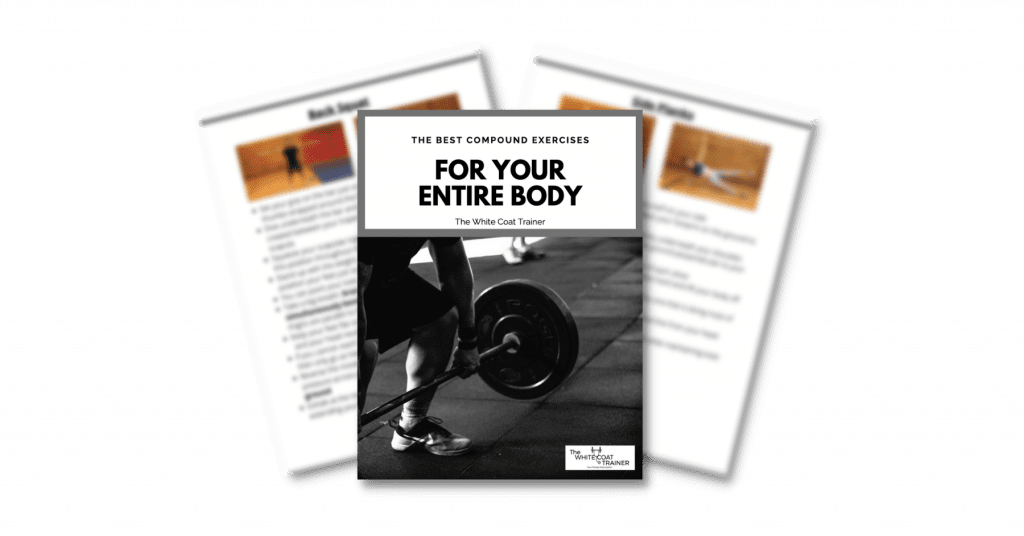Developing a strong posterior chain is a vital component to having a strong healthy body.
Far too many people over-emphasize their ‘mirror muscles’ such as the chest, the abs, and the quads and undertrain the posterior side. This can lead to muscle imbalances, pain, and injury.
Fortunately, there are many compound exercises that can train all of the posterior chain muscles (glutes, hamstrings, and low back) at once. The back extension (aka the back raise) is one of them.
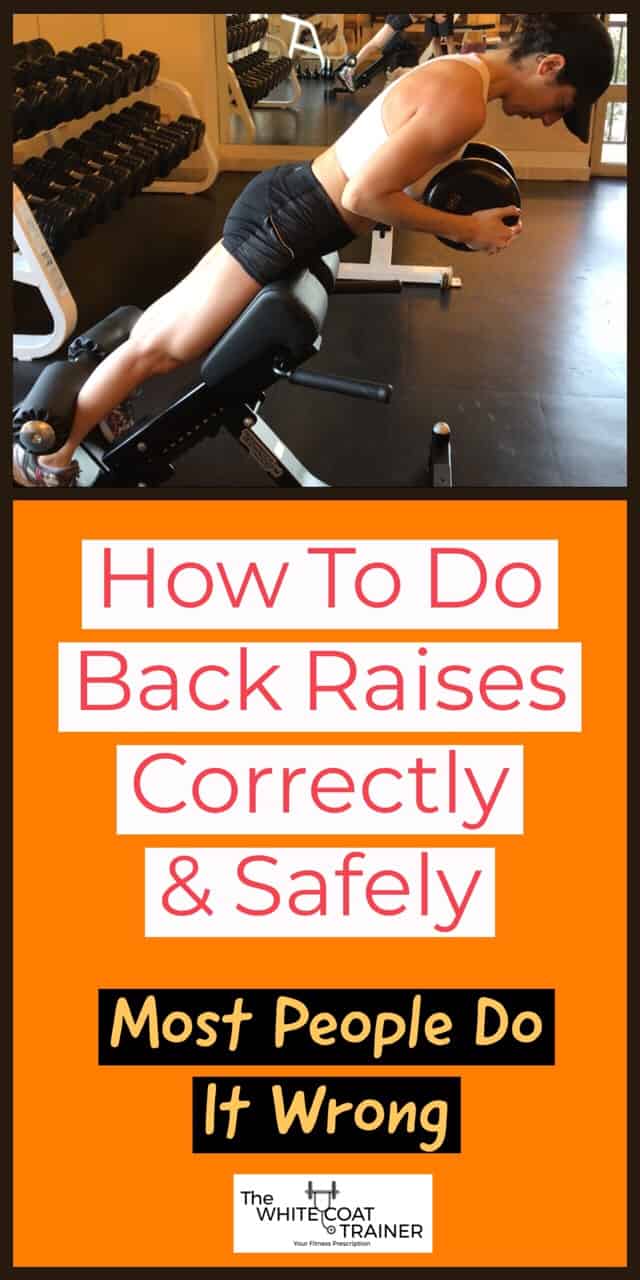
BACK RAISE VS BACK EXTENSIONS VS GLUTE HAM RAISE
Back raises and back extensions are not the same exercise. They are different.
Back Raises are performed on a 45 degree back raise machine. They train the muscles of the posterior chain which includes the low back and the posterior legs.
Back Extensions are an exercise meant to train the upper back and improve thoracic extension. Smitty Diesel made a good article on this.
Glute ham raises require a GHD machine. They train your posterior chain through flexion of the hamstring muscles. This exercise does not train the lower back muscles as much.
Please do not call any of these exercises hyperextensions.
You do not want to hyperextend your back under load under any circumstances.
With that said, many people use the terms back raise and back extension interchangeably, so that is what I will do in this article.
Back extension is the more popular name.
HOW TO DO A BACK EXTENSION (BACK RAISE) WITH PROPER FORM
WHAT ARE BACK EXTENSIONS GOOD FOR? (TOP BENEFITS)
- Activate the glute muscles which are often dormant in the general population
- Strengthens the muscles of the low back and the posterior chain, which are often under-developed when compared to the quadriceps muscles
- Improves hip extension, and isometric back strength, which is necessary for lower back health
WHAT MUSCLES DO BACK EXTENSIONS ACTIVATE / WORK?
- Glutes
- Hamstrings
- Adductors
- Spinal Erectors (Erector spinae)
- Other Lower Back Muscles
PERFORMING THE BACK EXTENSION WITH PROPER TECHNIQUE
- Approach a back raise machine that is set to a 45-degree angle
- Ensure that the padding for the legs is at a height where you can bend from your spine without difficulty
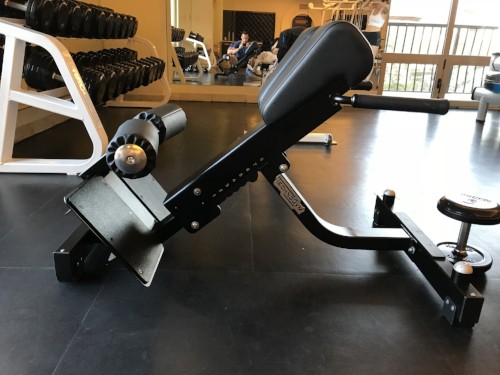
- Position yourself on the machine by resting your upper thighs on the support pad and lock your ankles behind the ankle padding
- Stand up tall, brace your core, and keep your spine an neck neutral. This is the start position
- You can choose to keep your arms across your chest, or you can perform it with a light weight held in front of your chest
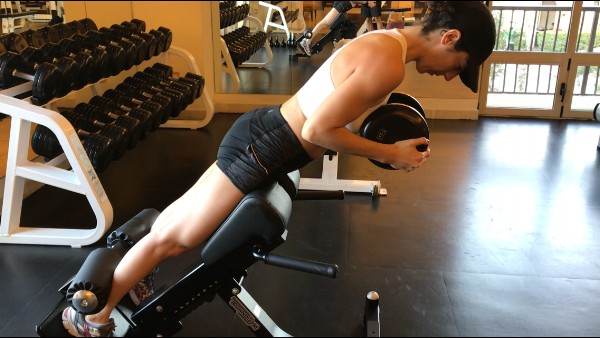
- From this position, begin bending at the hips while keeping your legs relatively straight (a slight bend in the knees is okay)
- You will begin to feel a stretch in your hamstrings
- Keep going until you reach your end range of motion. You’ll most likely be able to bend to at least 90 degrees of hip flexion
- Ensure that you maintain a neutral spine throughout the full range of motion
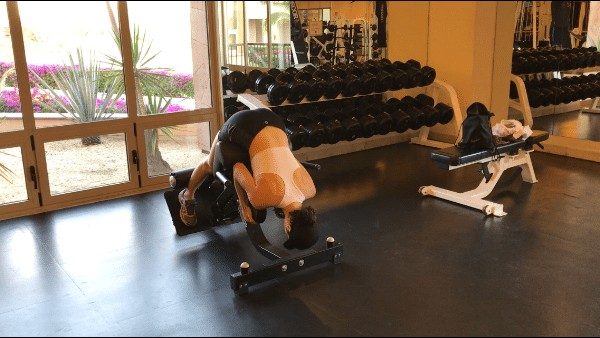
- Reverse the movement by raising your back, back to its starting position without changing your spinal alignment
- Once you’re almost upright, flex your glutes hard
- Stop the motion once your back is neutral (i.e, a straight line)
- DO NOT HYPEREXTEND your back beyond the neutral position
This exercise can easily be scaled with added weight. Simply hold a dumbbell across your chest.
COMMON BACK RAISE MISTAKES
HYPER-EXTENDING AT THE BACK
This is dangerous and can cause significant injury to your lumbar spine, especially if you are adding external resistance.
Flex your glutes at the top of the movement and stop when your torso is upright and your spine is neutral.
By the way, if you would like to get a PDF that outlines all of the very best compound exercises for every muscle group in your body – check out my E-book!
All exercises have images, a detailed description of how to do them properly, and a link to a video!
FREQUENTLY ASKED QUESTIONS
Are Back Extensions/ Raises Bad For You?
No, back raises are not bad for you. It is a completely natural movement pattern that trains the muscles of the posterior chain. If done with improper form, (aka hyperextending at the back) you are putting yourself at risk of developing a spinal injury.
My Back Hurts When I Do Back Raises. What Should I Do?
This is likely due to a technical issue. Ensure that you are NOT hyper-extending at the back and stop the exercise once you reach a neutral position.
If your back continues to hurt, then look for other causes of lower back pain such as poor posture from anterior pelvic tilt.
What Type of Movement Is The Back Extension?
The back extension is a hip hinge or hip extension movement.
How Can I Do The 45 Degree Back Extension At Home Without The Machine?
Unfortunately, it is difficult to recreate this exercise without the back extension machine.
However, we do have many close alternatives to this exercise that train the same muscles in a similar fashion. These include the Romanian deadlift and good morning which you can check below.
Back Extension Alternatives
Not everyone has access to a back raise machine in their commercial or home gym. Fortunately, there are other lower body exercises that resemble this movement pattern.
Are Back Extensions Worth Doing?
Back extensions are worth doing because they are one of the best ways to train hip extension and improve lumbar strength. This exercise can also be done isometrically (i.e, holding the top position for time) to improve your lower back endurance.
How Can I Improve My Back Extensions?
The best way to improve any exercise is to go through the range of motion in a slow and controlled manner.
Take your time when doing this exercise and feel the lower back muscles get activated.
Over time you can add resistance by holding a dumbbell or a weight plate at your chest and including isometric sets.
Are Back Hyperextensions Safe?
Back extensions are a safe exercise. Hyperextensions, with additional weight, may not be as safe. You should always perform this exercise by stopping once your back has reached a neutral position.
With that said, bodyweight hyperextension exercises (like the cobra or the upward dog) can be beneficial for improving spinal mobility and strength.
Do Back Extensions Help Deadlift?
The back extension is a great accessory exercise for improving your deadlift. It trains the spinal erectors, glutes, and hamstrings, all of which are important for executing the standard deadlift appropriately.
Do Back Extensions Work Abs?
Although this exercise is primarily a lower back exercise, it also trains your abdominal muscles through spinal stabilization.
Are They Good For Glutes?
Back extensions are great for targeting the lower back and hamstrings, but they will also strengthen the glutes.
Developing these three muscle groups is great for injury prevention if you suffer from muscular imbalances.
Can I Do Back Extensions Every day?
You should not do any exercise every day except for walking. Training the back raise (or other forms of hip extensions) two times per week is sufficient.
How Can I Integrate Back Raises / Extensions Into My Routine?
Check out Our Best Workout Template, where we provide a simple way to integrate the back raise and a bunch of other beneficial exercises into your training session.
Best of all, the workouts only take 30 minutes, making it a great option for busy professionals.
FINAL WORDS
The back raise/hyperextension is a great exercise for developing lower back strength while also training the underutilized glutes and hamstring muscles.
As with all exercises, take your time when doing this movement and avoid hyperextending at the back for maximum safety.
OTHER SIMILAR EXERCISES TO THE BACK RAISE

Alex Robles, MD, CPT / Brittany Robles, MD, MPH, CPT
Alex & Brittany Robles are physicians, NASM Certified Personal Trainers, and founders of The White Coat Trainer: a resource dedicated to improving the health and fitness of busy professionals using time-efficient strategies. Their advice has been featured in My Fitness Pal, Prevention, Livestrong, Reader’s Digest, Bustle, The Active Times, and more. Learn more about them here.

